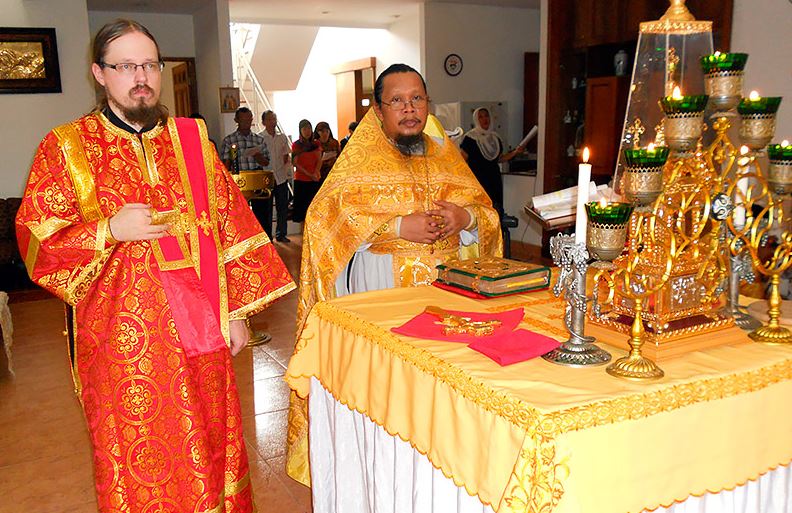
Frs George and Ioasaph Tandibilang
by Fr. George Maximov
What is the Crown Princess of Bali doing in an Orthodox church, why do Russians prefer to confess to Indonesians, and why Orthodoxy is a blessing for Indonesia—these and other themes are discussed in the Indonesian notes of Fr. George Maximov.
The first thing that struck me upon landing in Jakarta was how undeveloped the airport was. You didn’t have the familiar electronic information boards—you had to walk up to someone who works there and ask them which baggage belt they were unloading luggage from such-and-such a flight on. I was also amazed at the Indonesian practice of gluing large photographs of themselves onto their carryalls and suitcases, with their telephone number written underneath—apparently they are easier to find in case of loss. But when these suitcases with the portraits of their owners are moving one after the other on the baggage belt, it looks pretty funny.
The city itself is large, but by comparison with, for example, Bangkok, it doesn’t produce such a good impression.
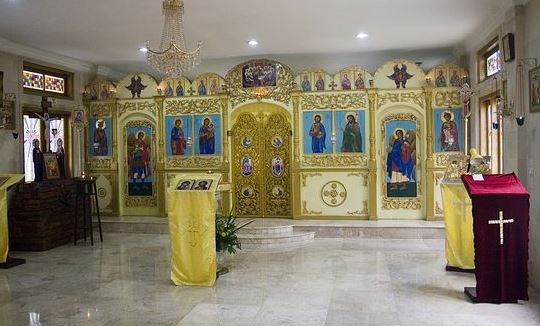
I had occasion to serve an all-night vigil in St. Thomas’s Church in Jakarta (ROCOR). The rector was an Indonesian, Fr. Boris. When I saw him, I thought that he was hardly over 20, and the thought flashed through my mind:
“How could they have ordained such a young man?”
It turned out that he was really 38 years old. Asians tend to look younger than their age, but Fr. Boris broke all records in this regard.
I found Indonesian Orthodoxy very touching, both in this church and in another that I served in. The priests, the servers, the choir, and the parishioners are all Indonesians, mostly former Moslems. No ‘white’ missionary travelled to them or preached—these Indonesians converted themselves, preach to others themselves, serve themselves, and try to lead a Christian life themselves. St. Nicholas of Japan’s preaching was very well organized, so that for the most part he was the only Russian missionary, while the Japanese converts—catechizers and priests—carried out the business of preaching; he only guided them and set them on the right course. It was thought through splendidly. And in Indonesia we see something even more amazing: where there is not one single missionary come from the outside at all to direct and supervise, but where everything is done by the Indonesians themselves.
Among the parishioners one older couple comes to mind—the Crown Princess of Bali and her husband. She converted to Orthodoxy when her husband was in a coma and the doctors did not give him a favorable prognosis. But this grandmother began to pray fervently that the Lord would, if even for a short time, allow him to regain consciousness, so that he would be able to receive baptism and not die unbaptized. And the Lord fulfilled her request and then some: not only did her husband regain consciousness, but he completely recovered. Now they both go to church. When she found out that I was Russian, the Princess shared the news about the fact that they were going to go on a pilgrimage to Russia and were very excited about it.
St. Thomas the Apostle Church itself was built by a rich Orthodox Indonesian family. After the service, I talked with the mother of the family, Mrs. Christina N, and asked her how they came to convert to Orthodoxy (she has, by the way, eight children). She confessed that they had all been Moslems. Once she was at the beach, and a tragedy happened: some people came up to her and told her that her daughter had just drowned, and they pointed to the place where she had disappeared under the waves. Christina ran there immediately. She went into the water and began to go in the indicated direction. One can just imagine what feelings she experienced, going in search of her child who had just died! And as she was going along, getting deeper into the water with every step, suddenly the thought flashed through her mind: “If Jesus is God, let my daughter be alive!” And a miracle occurred: she spotted her daughter under the water, and when she lifted her up and carried her in to shore, the girl came back to life!
It is no wonder that after this miracle not only Christina, but also her husband and all their children were baptized. They didn’t know anything about Orthodoxy, and therefore they became Protestants, as Protestants had long been in Indonesia and were well known to all. Now after her baptism, Christina began to read the Bible. She read it through several times in full—from Genesis to the Apocalypse. And during her reading of the Acts of the Apostles and the epistles, it struck her that the Christian Church had been one, united Church, and that that completely did not apply to the fragmentation that Christina saw among the Protestants. She resolved to find out what had happened to the very first, original Church. And to find this out she set out for the place where it all began—in Jerusalem, in the Holy Land, which was possible thanks to her good financial situation. There she discovered that this Church, founded 20 centuries ago, still exists to this day, and that it is the Orthodox Church. Finding it, Christina convinced her whole family to become Orthodox.
As has already been mentioned, Christina and her husband built a church in honor of the Apostle Thomas on their own land in Jakarta. Unfortunately, not everyone liked this—one Moslem organization was outraged by this. It gathered a crowd of its supporters together and sent them to the Orthodox church. The whole territory was occupied by angry Moslems, many of whom were armed with knives. They were shouting that they would destroy the church and kill the priest, and they were demanding that we hand him over to them. Retelling this, Christina said that it was really terrifying. Glory to God, that time nothing serious happened, and after they had made a lot of noise, the crowd dispersed. But the leader of this organization announced that this was not the end of it, and that they would fight against our Orthodox parish church. However, it so happened that in the course of a year they all died. In their place came other leaders, who had changed their opinion so much, that now this Moslem organization officially rendered protection to the Orthodox parish.
As is well known, Indonesia has the highest concentration of Moslem population in the world, in spite of the fact that, by its constitution, it is a secular state. And this is a country where in several areas there have been hotbeds of tension in the relations beween Christians and Moslems in the last years. This cannot but have its effect on Orthodox society, although the latter is still comparatively small.
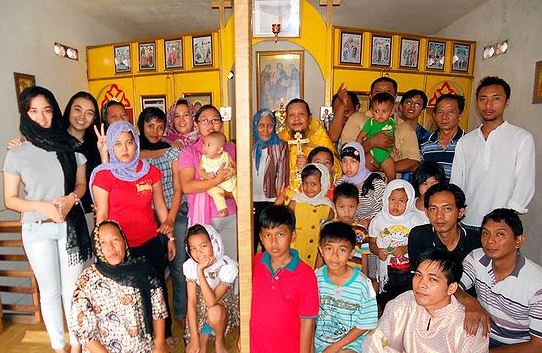
For example, there was an incidence where an Orthodox priest from abroad came to Indonesia by the invitation of the Indonesian (Orthodox) community in order to help them with preaching and serving, but this evoked a very negative reaction on the part of the local Moslems: they sent threats, and he had to leave the country.
Because of the opposition of Moslem societies, in many regions it is extremely difficult to receive permission to build a church—and even if you receive it, there are cases where afterwards Moslem activists come to the building site and physically hinder the building work, and thus the church is left unbuilt.
But, it needs to be noted that nevertheless, Indonesia is not a country under Sharia law, and moreover there are regions where the majority are non-Moslems. For example, on the island of Bali it is basically Hindus who live there, and in the Province of Papua, Protestants. There are also areas populated by tribes which to the last man confess heathenism.
Despite some difficulties, I must say that the Lord protects the Orthodox, and in the past years there have not been any incidents where our churches have been blown up, or our brothers and sisters massacred, as took place in regard to the Protestants.
The next day I served at Liturgy in the parish of the Holy Equal-to-the-Apostles Prince Vladimir (Moscow Patriarchate). The rector here was Hieromonk Ioasaph (Tandibilang), and helping him was Deacon Basil Manuputi. When I was in Jakarta, the services were still performed in an apartment—we didn’t have our own church. The temporary church was situated in the home of one of the parishioners—a widow whose only property was this house. She had thoughts about renting this apartment, but Fr. Ioasaph said to her, “Have faith: as long as you offer your house for the divine services, the Lord will take care of you, so that you will not be in need of money.” She believed, and so it was: all seven years that she offered her house free of charge for the services, her children received very good jobs, so that their salaries were enough to cover her own needs as well. Now Fr. Ioasaph has already built a separate church on land that an old Russian emigré, Vladimir, who died several years ago, willed for that purpose
Fr. Ioasaph’s manner of preaching made an impression on me. His sermons were in Indonesian, and when I listened to them, I had the strange feeling, that although I didn’t understand a word of Fr. Ioasaph’s speech, I believed him, because you could only speak the way he spoke, about the truth.
Although his sermons are long, he holds his listeners’ attention very well: he has a good feel for timing, he knows how much time he has left. So that the parishioners wouldn’t get tired from standing a long time, Fr. Ioasaph introduced the practice of sitting during the sermon. And that, perhaps, is the only difference from what goes on in our Russian churches—Fr. Ioasaph is an expert and zealot of the services according to the Church rules and of the traditions of Russian Orthodoxy, so that, in his parishes, everything is exactly the same as is commonly done, as he was taught in Russia. At that time he had two parishes—in Jakarta and Surabaya, and now Bali has been added.
Looking at Fr. Ioasaph preaching and at the attention that he commands, I was amazed, and wondered whether all Orthodox priests here were such Chrysostoms. It turns out that not all are—only the founder of the mission in Indonesia, Archimandrite Daniel (Bayantoro) and Fr. Ioasaph.
Thanks to such talent, on the evening of the same day that we served Liturgy, Fr. Ioasaph was invited to Deacon Agapit’s house (ROCOR) to give a speech in memory of the latter’s mother-in-law. Fr. Ioasaph took me with him. Inasmuch as many non-Orthodox people were coming to the memorial, it was necessary to devote a few words in general to the Orthodox understanding of a person’s lot beyond the grave, and also to the question of why we pray for the dead (which the Protestants do not do). It is worthy of respect, that Orthodox Indonesians try to use any opportunity for their mission that presents itself.
And so, closer to evening we drove to the place. I thought, “Someone close to these people has died. They are in mourning, and I should look like I am, too.” However, when we arrived, I saw smiling people in a good mood. They didn’t look at all like people in mourning, as we understand it. There really were a lot of people there! Everything began with a pannikhida, which Fr. Boris served, then there was a sermon by Fr. Ioasaph. After that Fr. Agapit gave a short eulogy about the deceased, and then suddenly a cake was brought out and everyone began to sing “Happy Birthday to you.” And then I found out, to my amazement, that the Indonesians had decided to combine the memorial of Fr. Agapit’s mother-in-law with his wife’s birthday. I looked at what was going on and realized that if you told anyone in Russia about something like this, it would be perceived as blasphemy. But these Indonesians were equally sincere in both the first half of the celebrations and the second. You didn’t feel at all as if anything weren’t right—it all looked natural, although we, of course, could not even imagine such a thing. That’s how important a difference in mentality can be.
Fr. Ioasaph, too, had been a Moslem. I asked him how he had converted to Christ. He told me that he had always taken religious life seriously, and he had had questions about his faith, for example: why was it necessary to pray exactly five times a day? Why couldn’t you translate the Koran into Indonesian, why did the holy text have to be only in Arabic? He posed such questions to the imam and teachers of Islam, but they answered,
“Don’t ask, just do as it is prescribed.”
“But I didn’t want to do something, not knowing why,” confesses Fr. Ioasaph. “And then I began to look at Christians. At first I went to the Protestants, but they couldn’t resolve all my questions, either. In addition, I saw some questionable things with the Protestants: praying to guitar accompaniment, dances, etc. I asked myself: is it correct to serve God as if you were at a disco or bar? And then I heard that there was a new religion in Indonesia, where they serve differently, where they perform their prayers in a dignified manner, where the women cover their heads and so on, and I asked, “What religion is that?” They told me that it was Orthodoxy. Then, in 1996, I met with Fr. Daniel (Bayantoro) and asked him many, many questions—two days in a row I questioned him, and he answered everything. And thus I realized that Orthodoxy is the true religion.
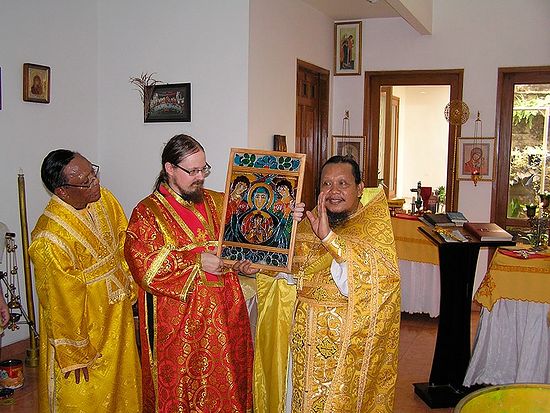
I still remember the story Batiushka told me of how he learned to venerate the Mother of God. After his conversion to Orthodoxy he experienced the same thing that all converts from Protestantism do: with his mind he acknowledged the Orthodox teaching on the Mother of God, but in his heart he was indifferent: he never prayed to Her, never venerated (kissed) Her icons, and so forth.
Now when he was getting ready to go to Russia to study at the seminary, he quit his job, sold part of his belongings, and bought a ticket. And, in accordance with the requirements, he had to pass a medical examination and blood and urine screenings. But when he went to find out the results, they told him,
“You have a terminal disease in the last stage, and it’s unlikely that you will even live a month longer.”
He was thunderstruck.
“I came home, locked myself in my room and cried all day and all night, and didn’t even eat or drink,” recounted Fr. Ioasaph. “The next day, I suddenly remembered that I had in my breast pocket a small icon of the Mother of God that someone had given to me. And it was as if a voice in my mind said to me, “You have a Mother, you know—beseech Her!”
Fr. Ioasaph took out the little icon and began fervently to pray to the Mother of God, that She would save him. And he spent yet another whole day and night in prayer. The next day was Monday, and Fr. Ioasaph left the house to go to the hospital. He was riding in the elevator with an elderly man, who asked him why he was so sad. Fr. Ioasaph told him about his misfortune, and then the stranger invited him to come with him. It turned out that he was the head of a private clinic. There they did blood tests, and the tests did not support the diagnosis that he had received. So after this incident Batiushka acquired sincere love for the Mother of God.
In Russia, he studied at Belgorod Seminary, and there he was also ordained. He recalls that when, after his ordination, they sent him off to hear confessions, he asked,
“But how will I be able to do that, seeing that I still understand and speak Russian poorly?”
One of the priests joked,
“Don’t worry! Whatever they tell you, just raise your eyes to heaven and say, ‘Oy, oy, oy!’
Fr. Ioasaph took this seriously and went over to the analogion. This babushka began to confess to him and said something. Fr. Ioasaph raised his eyes upwards and said, “Oy, oy, oy!”1 The bábushka looked at him and said,
‘What do you mean by “Oy, oy, oy”?
But later—I heard this from Metropolitan John of Belgorod—when the parishioners found out that Fr. Ioasaph didn’t understand Russian very well, he became the most popular confessor in the parish. They stood for him in lines longer than for any other of the other priests—lines consisting of those who had given in to the false shame of really confessing their sins, or to lame thoughts like “the priest will tell my confession to other people” or “Fr. So-and-so will be disappointed with me.” It is too bad that not everyone realizes that an open confession—despite this shame and such thoughts—makes the confession sincere and gives a feeling of freedom from sin. In Indonesia some Russians purposely do not go to Fr. Ioasaph for confession, since he now understands Russian very well, but go to other Indonesian priests, confessing to them in Russian, so that they would, without understanding what they heard, then simply read the prayer of absolution. Such a deceitful confession is a confession without confession, in order to simultaneously tell one’s sins to the priest, supposedly, but while doing so remain as if they had not been told.
When I was in Jakarta, I saw some Russians there put pressure on Fr. Ioasaph, saying that the land that the church was on, which was donated by the emigré mentioned above, wasn’t suitable, because it was situated unbelievably far away, and it would take them too long to get there. Instead of this, they proposed that he sell this land and with the help of some machinations try to get the use of a parcel of land in the center of the city. The matter was totally not doable. Fr. Ioasaph and I went to look at the land, and I purposely noted how much time it took to get there. Then I said to those Russians,
“I checked, and it takes an hour to get there.”
They replied,
“There you go, you have to be on the road a whole hour!”
I, then, marvelled:
“As a matter of fact, I personally also travel an hour to my church in Moscow, in order to get to services. And so do many Muscovites. Why do you, living in Indonesia, a non-Orthodox country, think that the church should be closer to you than to people who live in the capital of Russia?”
I think that Fr. Ioasaph did the right thing, that on balance he built the church on the land the he already had in hand, rather than getting involved in some risky venture.
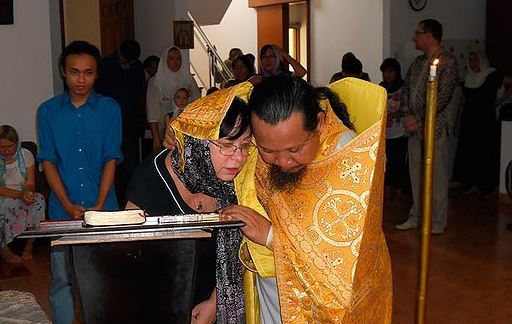
If we return now to the subject of Indonesian Orthodoxy, one sad circumstance needs to be noted, that is, the jurisdictional division, intensified from without. Missions from the Church of Constantinople and from the Russian Church Abroad function in this country, and there are also parishes of the Moscow Patriarchate. And although all the clergy and laity are Orthodox Indonesians, they do not associate with each other, to a large part because of the hostile position of the hierarchs of the Church of Constantinople, who regard only themselves as “canonical,” and stigmatizing all the others as schismatics, and forbidding their faithful to associate with them. All this, of course, is crazy, and is a grave sin, because of which obstacles are arising in the very first steps of Orthodoxy in Indonesia. And what is more, this is not from unbelievers, but from the “Orthodox bosses” across the sea.
I also should say something about the sights in Jakarta, or rather, about the most memorable one—”Little Indonesia Park.” Within quite a large space there are situated sectors; in each of the sectors buildings and homes have been built in the traditional style of one people or another who have settled in Indonesia. One may look around it all, both from above in a cable car, and below, going into each house and examining the traditional way of life of the given people. It is very well done, and it is unbelievably interesting to take a walk there. You need to reserve a whole day to visit this park. Far less time was at our disposal, so we covered only a small part of it.
Fr. Ioasaph took me to an exposition that presents the culture of the people who live in the Sumatran mountains. Part of the people to this day are pagans, and they have some quite difficult rules of burial. It is regarded as possible to perform the burial only after you bring a large number of cows as an offering to the spirits (I have already forgotten just how many now). There is no way an ordinary family can afford to buy this many cows all at once—it’s too expensive. So they labor for a year or sometimes more in order to save up enough money for the performance of the ritual. And all this time the decomposing corpse of the deceased is supposed to remain in the home, alongside the living—including children! For me, this was one of the examples of how evil spirits mock the heathen, who have fallen under their power.
And after carrying out the ritual the burial is performed—they put the remains in a specially hollowed-out crypt in a cliff, and at the entrance to the crypt they put a wooden statue of the deceased, full-length, in his own clothes. If you look at this from far away, it seems as if living people are sitting there, but up close it becomes clear that this is a cemetery.
In conclusion, I would like to quote Fr. Ioasaph’s words, which he spoke to me in answer to a question on the prospects of Orthodoxy in Indonesia:
I think that Orthodoxy is a blessing for our country. I see that in other Christian confessions a person’s life does not change very much for the sake of God. But when people become Orthodox, they change for the better, and this is noticeable to all. So, it isn’t hard to say that Orthodox people are different people, because with us, everybody looks not so much at what someone says, as how they lead their life. And people say, ‘What should we accept a religion for, if it doesn’t change a person’s life?’ And, glory to God, Orthodoxy gives a person the strength to change, and this is God’s blessing for Indonesia.”
1 Oy, oy, oy!—an eminently Russian exclamation which has no real equivalent in English. It can mean anything from an expression of sympathy: “Oh, dear me!” “Oh, that’s awful!” “Oh, I’m so sorry to hear that!” to acknowledging that something is a serious problem: “Oh! What are we going to do?” to absolutely telling someone off: “What did you do that for?! You shouldn’t have done that!”

Great read Fr George. Thank you for sharing 🙂